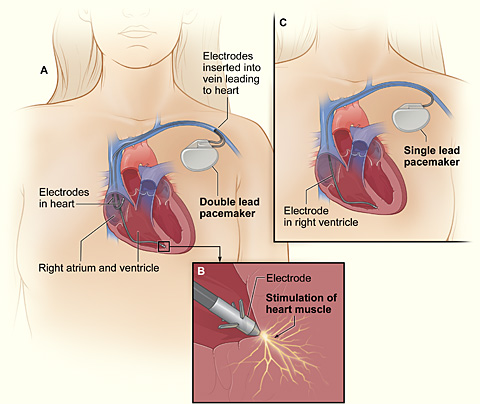Cardiac pacemaker
Cardiac Pacemaker[edit | edit source]
A cardiac pacemaker (KAR-dee-ak PAYS-may-ker) is an electronic medical device designed to regulate the heart's rhythm and rate. By delivering electrical impulses to the heart muscle, it aids the heart in maintaining a normal rhythm, especially when the heart's natural pacemaking capabilities are compromised. Also known as an artificial pacemaker or simply pacemaker, this device has revolutionized the treatment of certain cardiac arrhythmias.
Structure and Function[edit | edit source]
- Battery: The power source of the pacemaker, designed to last several years depending on usage and type.
- Pulse Generator: Produces the electrical impulses that stimulate the heart.
- Leads: Long, thin wires that connect the pulse generator to specific regions of the heart. They transmit the electrical impulses and also detect the heart's own electrical activity.
Indications for Use[edit | edit source]
Cardiac pacemakers are typically recommended for patients who have:
- Bradycardia: An abnormally slow heart rate.
- Heart block: An interruption in the electrical pathways of the heart.
- Certain types of arrhythmias: Irregular heart rhythms that can be life-threatening or cause significant symptoms.
Implantation[edit | edit source]
The pacemaker implantation procedure is generally a minimally invasive surgery, often performed under local anesthesia. A small incision is made, usually in the chest area, through which the pacemaker is inserted and the leads are guided to the heart using fluoroscopic guidance. Once in place, the device is tested to ensure proper function, and the incision is closed.
Monitoring and Maintenance[edit | edit source]
Post-implantation, routine follow-up appointments are crucial:
- Device checks: To monitor battery life and ensure the pacemaker is functioning correctly.
- Lead assessments: To ensure the leads remain in the proper position and are effectively transmitting signals.
- Adjustments: The pacemaker settings might be adjusted depending on the patient's needs.
Patients are also educated on recognizing signs of potential complications and the importance of avoiding strong electromagnetic fields which might interfere with the device's function.
Advancements[edit | edit source]
Modern pacemakers have evolved to incorporate features like MRI compatibility, rate-responsive pacing (where the device adjusts the pacing rate based on the body's activity level), and dual-chamber pacing (which can pace both the atrium and ventricle of the heart).
See Also[edit | edit source]
References[edit | edit source]
Search WikiMD
Ad.Tired of being Overweight? Try W8MD's physician weight loss program.
Semaglutide (Ozempic / Wegovy and Tirzepatide (Mounjaro / Zepbound) available.
Advertise on WikiMD
|
WikiMD's Wellness Encyclopedia |
| Let Food Be Thy Medicine Medicine Thy Food - Hippocrates |
Translate this page: - East Asian
中文,
日本,
한국어,
South Asian
हिन्दी,
தமிழ்,
తెలుగు,
Urdu,
ಕನ್ನಡ,
Southeast Asian
Indonesian,
Vietnamese,
Thai,
မြန်မာဘာသာ,
বাংলা
European
español,
Deutsch,
français,
Greek,
português do Brasil,
polski,
română,
русский,
Nederlands,
norsk,
svenska,
suomi,
Italian
Middle Eastern & African
عربى,
Turkish,
Persian,
Hebrew,
Afrikaans,
isiZulu,
Kiswahili,
Other
Bulgarian,
Hungarian,
Czech,
Swedish,
മലയാളം,
मराठी,
ਪੰਜਾਬੀ,
ગુજરાતી,
Portuguese,
Ukrainian
Medical Disclaimer: WikiMD is not a substitute for professional medical advice. The information on WikiMD is provided as an information resource only, may be incorrect, outdated or misleading, and is not to be used or relied on for any diagnostic or treatment purposes. Please consult your health care provider before making any healthcare decisions or for guidance about a specific medical condition. WikiMD expressly disclaims responsibility, and shall have no liability, for any damages, loss, injury, or liability whatsoever suffered as a result of your reliance on the information contained in this site. By visiting this site you agree to the foregoing terms and conditions, which may from time to time be changed or supplemented by WikiMD. If you do not agree to the foregoing terms and conditions, you should not enter or use this site. See full disclaimer.
Credits:Most images are courtesy of Wikimedia commons, and templates, categories Wikipedia, licensed under CC BY SA or similar.
Contributors: Prab R. Tumpati, MD


